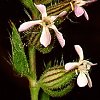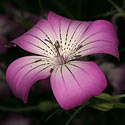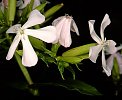|
Family: Caryophyllaceae (Carnation family)
Life
> eukaryotes >
Archaeoplastida >
Chloroplastida
>
Charophyta > Streptophytina > Plantae (land plants)
> Tracheophyta (vascular plants) > Euphyllophyta > Lignophyta (woody plants)
> Spermatophyta (seed plants) > Angiospermae (flowering
plants) > Eudicotyledons > Core Eudicots > Order: Caryophyllales
About 86 genera and 2200 species
(cosmopolitan but mainly north temperate regions, especially Mediterranean and
Irano-Turanean region), with 12 genera and 51 species native to southern Africa,
a further 11 genera and 22 species that are naturalised, and a further two
genera and 37 species that are cultivated in the region.
Genera native to southern Africa
Information from Jordaan (2000).
|
Cerastium
About 100 species (almost cosmopolitan
but mainly N temperate regions of the Old World), with
six species native to southern Africa and a further two
species that are cultivated in the region. |
|
|
Corrigiola
Eleven species (mainly Europe, Africa
and Chile), with four species that are native to southern
Africa. |
|
|
Dianthus (carnation genus)
About 300 species (Europe, Asia,
Africa), with 16 species native to southern
Africa and a further 14 species that are cultivated in
the region. The genus includes the Carnation Dianthus
caryophyllus, which probably originates from the
Mediterranean and is widely cultivated for its flowers.
|
|
|
Drymaria
About 48 species (mainly Americas) of
which one, Drymaria cordata, has a pantropical
distribution that includes southern Africa. See
Flora of Zimbabwe. |
|
|
Herniaria
About 47 species (Eurasia, Canary
Islands and Africa), with four species native to
southern Africa and a further species that is cultivated
in the region. |
|
|
Krauseola
Two species with a tropical East
African distribution one of which,
Krauseola mosambicina,
extends into Mozambique and northern KwaZulu-Natal. |
|
|
Pollichia
One species: Pollichia campestris,
with a distribution that extends from the Arabian
Peninsula, through East Africa and into southern Africa.
See
Flora of Zimbabwe. |
|
|
Polycarpaea
About 50 species (tropics and subtropics), with
two species native to southern Africa. |
|
|
Polycarpon
About 16 species (mainly Europe and
Mediterranean but also South America and southern
Africa), with one species native to southern Africa and
another that has become naturalised in the region. |
|
|
Silene
(Campion genus)
About 700 species (Eurasia, Africa and North
America), with 12 species native to
southern Africa, four species that are naturalised, and a further
eight species that are cultivated in the region. |
 |
|
Spergularia
About 25 species (cosmopolitan), with
two species native to southern Africa and a further two
species that are naturalised in the region. |
|
|
Stellaria
(chickweed, stitchwort genus)
About 90-120 species, with one species
native to southern Africa and a further two species that
are naturalised in the region. |
|
Genera naturalised in southern Africa
Information from Jordaan (2000).
|
Agrostemma (corncockles)
Two species (Mediterranean and
temperate Eurasia), of which one,
Agrostemma githago
(Common corncockle),
has become naturalised in southern Africa and is a
weed in fields. |
 |
|
Arenaria
About 150 species, native mainly to N
temperate regions; two species have become naturalised
in southern Africa and a further two species are
cultivated in the region. |
|
|
Holosteum
About three species (temperate Eurasia
plus one in Ethiopia), of which one, Holosteum
umbellatum, has become naturalised in southern
Africa. |
|
|
Moenchia
Three species (Europe, Mediterranean),
of which one, Moenchia erecta, has become
naturalised in southern Africa (Western Cape). |
|
|
Paronychia
About 110 species (native
distribution nearly cosmopolitan but not southern Africa
or SE Asia), of which one,
Paronychia brasiliana,
has been introduced to southern Africa from South
America and is a troublesome weed in lawns. |
|
|
Petrorhagia
Twenty-eight species (Canary Islands,
Europe, Mediterranean through to Kasmir), of which one,
Petrorhagia prolifera, has become naturalised in
southern Africa (southern Cape). |
|
|
Sagina
About 30 species (nearly cosmopolitan
but not native to southern Africa), of which two,
Sagina apetala and Sagina maritima, are
naturalised in southern Africa, where they are found as
tiny weeds in lawns. In addition, Sagina procumbens
(Pearlwort) is cultivated in the region. |
|
|
Saponaria
(Soapwort genus)
About 20 species,
native to southern Europe and southwestern Asia. One species is
naturalised, and two species are
cultivated in southern Africa. |
 |
|
Scleranthus
About 10 species (temperate Eurasia,
Mediterranean, Ethiopia and Australasia), of which one,
Scleranthus annuus, was introduced to southern
Africa before 1900 and has become a problem weed in
wheat and lucerne fields. In addition, Scleranthus
biflorus (native from Tasmania to South America) is
cultivated in the region. |
|
|
Spergula
Six species (temperate Eurasia), of
which one, Spergula arvensis, is a cosmopolitan
weed that has been introduced to southern Africa. |
|
|
Vaccaria
Vaccaria hispanica (Cowherb,
Cowcockle, Cow-basil) is native to Europe and has
become naturalised in southern Africa. |
|
Other genera, cultivated in southern Africa
Information from Glen (2002).
|
Lychnis
Four species cultivated in southern
Africa. |
|
|
Gypsophila
Two species cultivated in southern
Africa: Gypsophila elegans (native to the
Caucasus and Turkey) and Gypsophila muralis
(native to Europe). |
|
Publications
-
Glen, H.F. 2002. Cultivated plants of
southern Africa. Jacana, Johannesburg.
-
Jordaan, M. 2000. Caryophyllaceae. In: Seed Plants of
Southern Africa (ed. O.A. Leistner). Strelitzia 10: 206-213).
National Botanical Institute, Pretoria.
|
